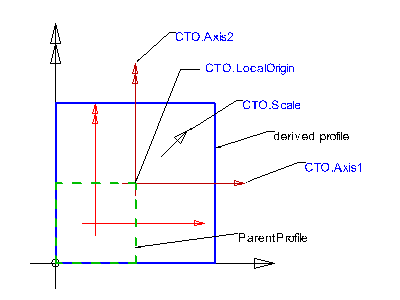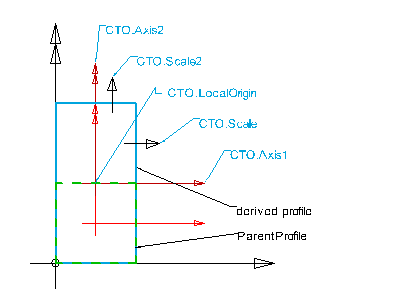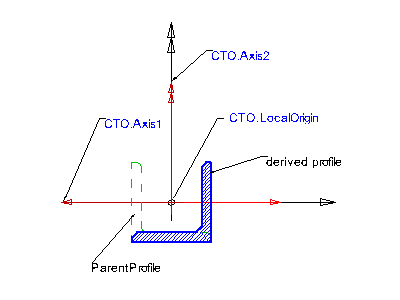Natural language names
 | abgeleitetes Profil |
 | Derived Profile Def |
 | Définition d'un profil dérivé |
Semantic definitions at the entity
Entity definition
IfcDerivedProfileDef defines the profile by transformation from the parent profile. The transformation is given by a two dimensional transformation operator. Transformation includes translation, rotation, mirror and scaling. The latter can be uniform or non uniform. The derived profiles may be used to define swept surfaces, swept area solids or sectioned spines.
The transformation effects the position, rotation, mirroring or scale of the profile at the underlying coordinate system, i.e. the coordinate system defined by the swept surface or swept area solid that uses the profile definition. It is the xy plane of either:
- IfcSweptSurface.Position
- IfcSweptAreaSolid.Position
or in case of sectioned spines the xy plane of each list member of IfcSectionedSpine.CrossSectionPositions. The position and potential rotation of the ParentProfile within the underlying coordinate system is taken into consideration before applying the Cartesian transformation operator.
Note, if only mirroring is required, IfcMirroredProfileDef should be used instead.
HISTORY New entity in IFC2x.
Figure 567 illustrates examples of derived profiles.
| |
Figure 567 — Derived profile |
Attribute definitions
| # | Attribute | Type | Cardinality | Description | G |
|---|---|---|---|---|---|
| 3 | ParentProfile | IfcProfileDef | The parent profile provides the origin of the transformation. | X | |
| 4 | Operator | IfcCartesianTransformationOperator2D | Transformation operator applied to the parent profile. | X | |
| 5 | Label | IfcLabel | ? | The name by which the transformation may be referred to. The actual meaning of the name has to be defined in the context of applications. | X |
Formal Propositions
| Rule | Description |
|---|---|
| InvariantProfileType | The profile type of the derived profile shall be the same as the type of the parent profile, i.e. both shall be either AREA or CURVE. |
Inherited definitions from supertypes
Entity inheritance

Attribute inheritance
| # | Attribute | Type | Cardinality | Description | G |
|---|---|---|---|---|---|
| IfcProfileDef | |||||
| 1 | ProfileType | IfcProfileTypeEnum | Defines the type of geometry into which this profile definition shall be resolved, either a curve or a surface area. In case of curve the profile should be referenced by a swept surface, in case of area the profile should be referenced by a swept area solid. | X | |
| 2 | ProfileName | IfcLabel | ? | Human-readable name of the profile, for example according to a standard profile table. As noted above, machine-readable standardized profile designations should be provided in IfcExternalReference.ItemReference. | X |
| HasExternalReference | IfcExternalReferenceRelationship @RelatedResourceObjects | S[0:?] | Reference to external information, e.g. library, classification, or document information, which is associated with the profile.
IFC4 CHANGE New inverse attribute | X | |
| HasProperties | IfcProfileProperties @ProfileDefinition | S[0:?] | Additional properties of the profile, for example mechanical properties.
IFC4 CHANGE New inverse attribute | X | |
| IfcDerivedProfileDef | |||||
| 3 | ParentProfile | IfcProfileDef | The parent profile provides the origin of the transformation. | X | |
| 4 | Operator | IfcCartesianTransformationOperator2D | Transformation operator applied to the parent profile. | X | |
| 5 | Label | IfcLabel | ? | The name by which the transformation may be referred to. The actual meaning of the name has to be defined in the context of applications. | X |
Definitions applying to General Usage
Concept inheritance
| # | Concept | Template | Model View |
|---|---|---|---|
| IfcProfileDef | |||
| Property Sets for Objects | Property Sets for Objects | General Usage | |
Formal representations
XML Specification
<xs:element name="IfcDerivedProfileDef" type="ifc:IfcDerivedProfileDef" substitutionGroup="ifc:IfcProfileDef" nillable="true"/>
<xs:complexType name="IfcDerivedProfileDef">
<xs:complexContent>
<xs:extension base="ifc:IfcProfileDef">
<xs:sequence>
<xs:element name="ParentProfile" type="ifc:IfcProfileDef" nillable="true"/>
<xs:element name="Operator" type="ifc:IfcCartesianTransformationOperator2D" nillable="true" minOccurs="0"/>
</xs:sequence>
<xs:attribute name="Label" type="ifc:IfcLabel" use="optional"/>
</xs:extension>
</xs:complexContent>
</xs:complexType>
EXPRESS Specification
ENTITY IfcDerivedProfileDef
SUPERTYPE OF(IfcMirroredProfileDef)
SUBTYPE OF (IfcProfileDef);
ParentProfile : IfcProfileDef;
Operator : IfcCartesianTransformationOperator2D;
Label : OPTIONAL IfcLabel;
WHERE
InvariantProfileType : SELF\IfcProfileDef.ProfileType = ParentProfile.ProfileType;
END_ENTITY;




 EXPRESS-G diagram
EXPRESS-G diagram Link to this page
Link to this page